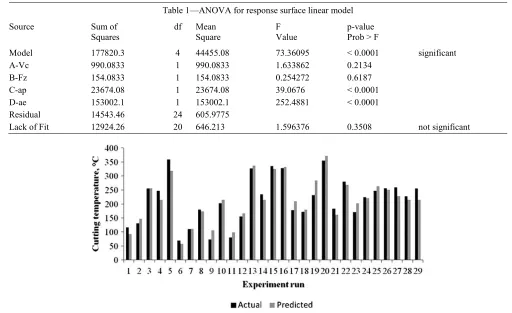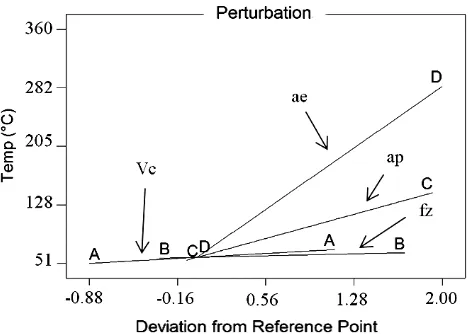Journal of Scientific & Industrial Research Vol. 73, January 2014, pp. 62-65
The influence of cutting parameter on heat generation in high-speed milling
Inconel 718 under MQL condition
MS Kasim1*, CH Che Haron2, JA Ghani2, MA Azam1, RIzamshah1, MA Md Ali1 and MS A Aziz1 1*Department of Process, Faculty of Manufacturing Engineering, Universiti Teknikal Malaysia Melaka, 76100
Hang Tuah Jaya, Melaka, Malaysia
2Department of Mechanical and Material Engineering, Faculty of Engineering and Built Environment, Universiti Kebangsaan Malaysia, 43600 Bangi, Selangor, Malaysia
Received 20 July 2012; revised 25 March 2013; accepted 26 April 2013
The paper presents a studyof the effect of operating variable parameter; cutting speed, feed rate, depth of cut and width of cut on heat being generated when end milling under MQL condition. The response surface methodology (RSM) was employed in the experiment, and a Box–Behnken design was used to determine the cause and effect of the relationship between the input variables and response. The investigated milling parameters were cutting speed (100 - 140 m/min), feed rate (0.1 - 0.2 mm/tooth), depth of cut (0.5-1.0 mm) and width of cut (0.2 -1.8 mm). Result of this study show ball nose end milling generates low temperature ranging from 69°C to 359°C. Experimental data and statistical analysis showed that heat generation was dominated by radial depth of cut, followed by axial depth of cut. Feed rate and cutting speed were found statistically not significant. The linear models were developed with a 92% confidence level. The optimum condition required for minimum heat generated include cutting speed of 117 m/min, feed rate of 0.11 mm/rev, axial depth of cut of 0.57 mm, and radial depth of cut of 0.21 mm. With this optimum condition, a minimum heat generated of 68°C was obtained.
Keywords: Inconel 718, End mill, Response surface methodology (RSM), Minimum quantitylubrication (MQL) Introduction
The concern towards green manufacturing has attracted many manufacturers to implement a Minimum Quantity Lubrication (MQL) with biodegradable lubricant on their manufacturing activities1. MQL is an alternative approach to reduce
temperature during machining as well as improving surface finish2-3. This cooling technique require a
small amounts of high-quality mist form lubricant and apply directly to the cutting tool/work piece interface instead of using traditional flood coolants4.
The advantage of MQL (air-lubrication mixture) is its capability to penetrate cutting zone to reduce friction on tool-chip interface by lubricating this vicinity region. The temperature generated during cutting process was majorly dissipated through chip and mist evaporation5,7. For ball nose type, it was notified the
maximum heat generated near depth of cut (DOC) line8. Ueda et al.3 in their research, investigate the
effects of MQL on the major cutting operations and conclude that MQL assisted cutting process capable to reduce heat between 60-100°C compare to dry
cutting. The temperature generated during milling with 600 m/min was 580°C compare to 660°C in dry milling.
Experiment details
The work-piece material used was a rectangular block of Inconel 718. The block was age hardened (42± 2 HRC). The chemical composition of the work-piece material confirms the following attribute (wt.%): 0.49 Al; 0.004 B; 0.051 C; 5.0Cb; 18.30 Cr; 0.04 Cu; 0.23 Mn; 3.05 Mo; 53.0 Ni; < 0.005 P; < 0.002 S; 0.08 Si; 1.05 Ti and balance Fe.The cutting parameters were set as the finishing process where the cutting speed, Vc of 100 – 140 m/min; feed rate, fz of 0.1 – 0.2 mm/tooth, axial depth of cut, ap of 0.5-1.0 mm and width of cut, ae of 0.2-1.8 mm. The insert was a 16 mm diameter ball nose end mill with the following features: WC-10% Co with PVD coating of multilayer TiAlN/AlCrN; relief angle 11°; radial rake angle 0° axial rake angle -3°. The milling operations were carried out on the DMC 635 V Eco CNC milling machine. The MQL nozzles were positioned so that the mist can be jetted out to the rake and flank face of cutting tool. According to a study by López de Lacalle et al.6, nozzle angle position of 130°
——————
KASIM et al.: THE INFLUENCE OF CUTTING PARAMETER ON HEAT GENERATION 63
is better than 45°. The distance between the nozzle and the tool is 30mm.The flowrate of MQL were set at 50 ml/hr. The medium of lubrication is biodegradable Coolube®2210EP, an advanced metal
cutting lubricant based on composition of natural esters which are formulated from renewable plant-based oils4. NEC Thermo GEAR Thermography
infrared camera with 2 megapixel was used. This camera capable to capture temperature of moving object by trigerring maximum temperature inside the spectrum image. Emisivity range between 0.1-1.0 and varied according to material to be captured. Emissivity value for inconel was set at 0.199.
Validation the captured temperature value was done by comparing the value of thermography camera and infrared thermometer at room temperature.
Developing the multiple regression model
In this work, mathematical models have been developed using RSM based on the experiment data. Situations where the curvature in the normal operating ranges is inadequately modeled by the first-order function that can be represented by the following equation10:
… (1) Where is the predictive Ra value; x1, x2, x3, and x4
are the coded values of Vc, fz, ap and ae respectively; e is the experimental error; and β0, β1, β2, and β4 are
the model parameters to be estimated using the experimental data.
Experiment results and discussion
The experiment results showed that end milling under MQL condition can achieve low heat generation. The achieved heat ranged from 70°C to 360°C.Details on the collected experimental data and the data calculated by mathematical modeling (Equation 1) are shown in Fig.1. The analysis of variance (ANOVA) was used to check the adequacy of model and significant contributing factors (Table 1). From ANOVA, the model F-Value of 73.36 indicates the model is significant. It was supported by the lack of fit value of 0.35 implies the model significant. The linear Box-Behnken model shows that radial depth of cut the highest effect on heat generation followed by feed rate while cutting speed
Table 1—ANOVA for response surface linear model
Source Sum of
Squares df Mean Square F Value p-value Prob > F
Model 177820.3 4 44455.08 73.36095 < 0.0001 significant
A-Vc 990.0833 1 990.0833 1.633862 0.2134
B-Fz 154.0833 1 154.0833 0.254272 0.6187
C-ap 23674.08 1 23674.08 39.0676 < 0.0001
D-ae 153002.1 1 153002.1 252.4881 < 0.0001
Residual 14543.46 24 605.9775
Lack of Fit 12924.26 20 646.213 1.596376 0.3508 not significant
J SCI IND RES VOL 73 JANUARY 2014
64
and feed rate were not significant toward heat generation. Fig. 2 is a graph of the actual response values versus the predicted response values. It helps to detect outlier values that are predicted by the model. The purpose of diagnostic is to check for lurking variables that may have influenced the response during the experiment. The plot show a random scatter trend indicates a time-related variable lurking in the background. The data points should be split evenly by the 45° line. It shows the correct transformation and fit model.
Prediction model equation
The first order model was developed to describe the relationship between cutting parameter (input) and heat generated (output). Hence the cutting temperature,
Tc was found to be:
… (2) This model depends only on cutting parameter. A comparison of the predicted value and experiment is graphically illustrated by Fig. 1. The average error was 10% since the factor of determination, R2 and adjusted
R2of 92.4% and 91.2 % respectively. The effects of
cutting parameters are shown in perturbation graph (Fig. 3). The graph shows trend of each factor that contribute to the response. Generally, the minimum value of cutting temperature, Tc is achieved at the negative side of every factors studied in this work. The graph also presents the optimum cutting parameter to obtain the lowest cutting temperature. It was found that the minimum temperature predicted was 68.8°C
by the combination of Vc 117.22 m/min, fz 0.11 mm/tooth, ap 0.57 mm and ae 0.21 mm.
Conclusion
This paper shows the relationship between cutting parameter and cutting temperature during end milling. A mathematical model has successfully developed base on RSM method with 29 series of experiments. This study shows the high speed machining can reduce heat generated during machining with radial depth of cut is the dominating factors. The experiment shows the MQL application able to reduce cutting temperature as low as 70°C during high-speed end milling Inconel 718.
Acknowledgments
This research would not have been possible withouttechnical and financial support from UniversitiTeknikal Malaysia Melaka, CRIM Division of Universiti Kebangsaan Malaysia and Government of Malaysia (project no. UKM-GUP-BTT-07-25-171).
References
1 Izamshah R, Mo J P T & DingS, Hybrid deflection prediction on machining thin-wall monolithic aerospace components,
J Eng Manuf, 226 B (2012) 592-605.
2 Shokrani A, DhokiaV& NewmanS T, Environmentally conscious machining of difficult-to-machine materials with regard to cutting fluids, IntJ Mach Tool Manuf, 57 B (2012) tribology in minimal quantity lubrication cutting, CIRP Ann - Manuf Tech,54 B (2005) 105-108.
KASIM et al.: THE INFLUENCE OF CUTTING PARAMETER ON HEAT GENERATION 65 5 Sharma VS, Dogra M & SuriNM, Cooling techniques for
improved productivity in turning,Int J Mach Tool Manuf, 49 B (2009) 435-453.
6 López LN& Lamikiz A, Experimental and numerical investigation of the effect of spray cutting fluids in high speed milling, J Mater Proc Tech, 172 B (2006) 11-15. 7 Rahman MM, Khan MMA & DharNR, An experimental
investigation into the effect of minimumquality lubricant on cutting temperature for machinability of AISI 9310 steel alloy, Eur J Sci Res.29 B (2009) 502-508.
8 Kasim MS, Che HaronC H, GhaniJ A, Sulaiman M A & Yazid M Z A, Wear mechanism and notch wear location prediction model in ball nose end milling of Inconel 718,Wear, 302 B (2013) 1171-1179.
9 Emissivity of Specific Materials,http://www.coleparmer. com/techlibraryarticle/254#anchor31. 2011, Accessed on 31 October 2012.

